mobile View, to the German Version tap the flag


- Vorarlberg
- Federal Country of the Republic of Austria
- former Austrian crown land: Country of Vorarlberg, consisting of: County of Bregenz, County of Feldkirch, County of Bludenz, County of Sonnenberg, County of Hohenems, Dominion of Blumenegg
• Flags
• Meaning/Origin of the Flag
• Coat of Arms
• Meaning/Origin of the Coat of Arms
• Map of the federal countries of Austria
• Map of the former crown lands of Austria-Hungary (to 1918)
• Numbers and Facts
• History
• Origin of the Country's Name
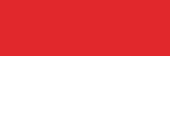
Flag of the country (Colours of the country),
ratio = 2:3,
Source, by: Wikipedia (D),
Colour, by: Dr. Peter Diem www.peter-diem.at



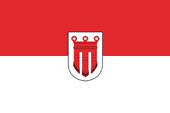
Official flag,
ratio = 2:3,
Source, by: Wikipedia (D),
Colour, by: Dr. Peter Diem www.peter-diem.at







The flag of Vorarlberg descents from the 19. century and shows two stripes in red and white. It was officially and lastly confirmed in 1946. The colours of the flag are derived from the colours of the coat of arms (red gonfanon on silvery ground).
In the time of the monarchy, the country had – like all the other crown lands of the Austrian crown – its own colours (Landesfarben), which were used amongst others on horizontally two- or three-striped flags. The colours (Landesfarben) were very often taken from the respective coat of arms of the country or were supplemented by another colour, which not appears in the coat of arms, or they went back to older models of the coat of arms (e.g. Carniola). Officially, the colours had never been regulated or stipulated, so that their sequence varied in practice or even the colors deviated. The Austrian heraldist Hugo Gerard Ströhl (1851–1919) was probably the first to take care of it and asked for the colors (Landesfarben) on the flags at the respective state authorities around 1890 and compiled them. For Vorarlberg, red and white were ascertained as the country's colors of the crown land.
Austria joined the German Empire in 1938 as one country. The federal structures played no role, they were completely replaced by the NSDAP districts (NS-Gau), the countries were abolished. From now on, offices and authorities had to use the empire's official flag. The corresponding national colors may still have exist, but not in the form of flags. They may have been used sporadically on SA uniforms or in some ranks of the Hitler Youth in the chest cord.
The flags of the Federal States of Austria are used with or without the coat of arms.
For official use, however, they always show it. The general population is permitted to use this format as well. There do not seem to be any legal regulations for the colours of the flags of the Austrian federal states; since they are apparently not defined, they are reproduced in practice within a usual standard range. However, the Austrian publicist and media scientist Dr. Peter Diem gives recommendations for the reproduction of the colours: For Vorarlberg, a medium red, most likely corresponding to Pantone 1795.
Source: Dr. Peter Diem austria-forum.org,
Wikipedia (D),
Flaggen Enzyklopädie,
Flags of the World,
Volker Preuß,
Österreichisch-Ungarische Wappenrolle


since 1918,
Coat of arms of Vorarlberg,
Source, by: See page for author / Public domain
Wikipedia (D),
Colour, by: Dr. Peter Diem www.peter-diem.at
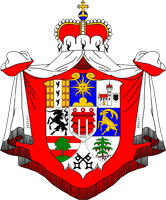
ca.1890–1918,
Coat of arms of Vorarlberg,
Source: Joseph von Bergmann, by: Ströhl, Wappenrolle Österreich-Ungarns, 1890, via Wikipedia (D)

1146–1667,
Coat of arms of the Palatines of Tübingen,
Source: Wikipedia (D)

1259–1534,
Coat of arms of the Counts of Werdenberg,
Source, by: Wikipedia (D)

The coat of arms of Vorarlberg shows a red gonfanon on a silver background. A gonfanon is an early form of flags that has been preserved as a church flag until today. In the word gonfanon is to find the old high German word "gundfano", which means "combat cloth". The coat of arms is described as follows in the law (Legaldefinition § 3 Abs. 2) of the Vorarlberg Land Symbols Act: "The red Montfortian banner with three equally wide, black-fringed stripes rests on a silver shield, and bears three red rings on the upper edge. The upper area of the banner has two, the gaps have three black cross lines." The Counts of Montfort were a Swabian-Vorarlberg family of counts, the original Palatines of Tübingen, named after Montfort Castle near Weiler in Vorarlberg, which died out in 1787. The family branched heavily into numerous secondary lines, all of which continued the coat of arms of the Palatines of Tübingen in different colors. The variation with the red gonfanon on silver was in 1918 still referred as the "Montfort red war banner", while the town of Feldkirch, which uses a black gonfanon on silver, expressly refers to the "peace flag of Montfort". However, the Counts of Werdenberg from the Montfort dynasty also used the black and white version. The territory of Vorarlberg was administered by Tyrol, belonged to Bavaria between 1806 and 1814, and became its own crown land of the Habsburg monarchy in 1861. However, it was still managed from Tyrol in many departments. The historian Joseph von Bergmann designed the coat of arms for the crown land, which was adopted in 1864. In its last version, the coat of arms was placed on a red and white (!) mantle and had nine fields. The three fields in the first row showed the heraldry of Bregenz, Sonnenberg and Feldkirch, the next row showed Bludenz and Hohenems, the lower three fields Dornbirn, Montafon and Bregenzerwald. The inescutcheon (heart shield) showed the Montfort coat of arms in its red and white version. The coat of arms was crowned with a princely hat. After the end of the monarchy in 1918, the country's coat of arms was limited to the uncrowned inescutcheon of the previous coat of arms and has been retained until today.
Source: Wikipedia (D),
Flaggen Enzyklopädie,
austria-forum.org,
Volker Preuß

The federal countries of Austria:
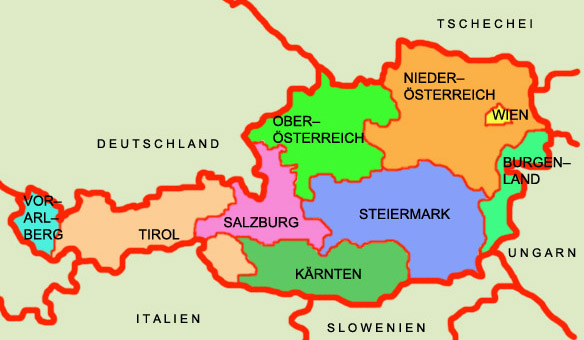
Source: Volker Preuß
• Burgenland
• Carinthia (Kärnten)
• Lower Austria (Niederösterreich)
• Upper Austria (Oberösterreich)
• Salzburg
• Styria (Steiermark)
• Tyrol (Tirol)
• Vorarlberg
• Vienna (Wien)

Map ca. 1910:
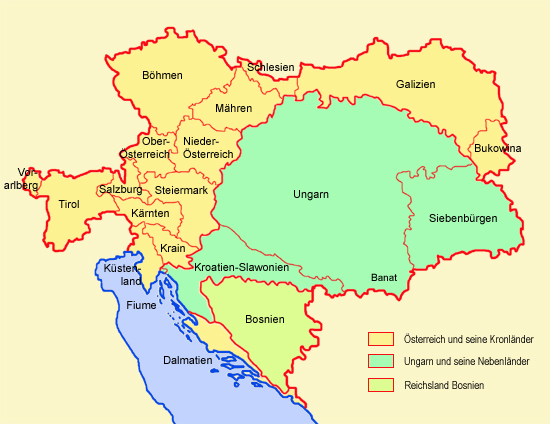
Source: Volker Preuß

Area: 1.004 square miles
Inhabitants: 397.100 (2020)
Density of Population: 395 inh./sq.mi.
Capital: Bregenz, 29.700 inh. (2020)
official Language: German
Currency: 1 Euro = 100 Cent
Time Zone: MEZ
Source: Wikipedia (D)

antiquity · in the today's Country of Vorarlberg settle Celts
since 15 B.C. · Roman conquest, establishment of the Province of Raetia
260 · invasions of the Alemannes
476 · dismissal of the last Roman emperor Romulus Augustulus, end of the (West)Roman Empire, the today's Vorarlberg comes to the Empire of the Eastern Goth
536 · conquest by the Frankish Empire
843/870/880 · at the division of the Frankish Empire comes Vorarlberg to the East Frankish Empire (later named German Empire)
1146 · Hugo I., Count of Nagold, becomes Count Palatine of Tübingen
1150 · his son Hugo married Elisabeth, heiress of Count Rudolf of Bregenz and Raetia Curiensis, heiress of Bregenz, Montfort and Sigmaringen
1152 · death of Hugo I., his son Hugo becomes Count Palatine of Tübingen as Hugo II.
1182 · death of Hugo II., his son Rudolf I. becomes Count Palatine of Tübingen, his second son Hugo III. inherits Tübingen and Montfort
1200 · Hugo III. is called Hugo von Montfort and thus becomes the progenitor of the Montfort dynasty, he builds the Schattenburg near Feldkirch, a village that will grow into a town in the future, the belonging property (which is sold to Habsburg in 1375) and the family line are called Montfort-Feldkirch, to differ from the numerous branching lines of the Montfort family (Montfort-Bregenz [until 1338], Montfort-Bregenz-Peggau [until 1574], Montfort-Werdenberg [until 1258], Montfort-Werdenberg-Heiligenberg [until 1535], Montfort-Werdenberg-Sargans [until 1505], Montfort-Werdenberg-Vaduz [until 1416], Montfort-Tettnang [until 1787], which occasionally own extensive properties along the Anterior River Rhine (Vorderrhein) in the east and north of Lake Constance
1363–1532 · the House of Habsburg gradually acquires: the Dominions of Neuburg am Rhein (1363), Feldkirch (1375), Bludenz (Montafon, 1394), Jagdberg (1397), Bregenz (1451 and 1523), Tannberg, Sonnenberg (1474), Hohenems, which for a long time are administered individually via bailiffs, however, common councils of states were formed which were heard by the sovereign in tax or defense matters, which from 1722 were called as "Vorarlberg council of states" (lying in front of Mount Arlberg), which were summarized in the "Bailiwick of Bregenz"
1751 · the "Bailiwick of Bregenz" is first called as "Bailiwick of Vorarlberg"
1765 · acquisition of the County of Hohenems – the last county of the Montfort-Dynasty – by the House of Habsburg, the "Bailiwick of Vorarlberg" is first called as "Country of Vorarlberg"
1779/1780 · due to financial problems, the Montfort-Tettnang line sells its remaining property to the House of Habsburg
1786 · establishment of the Tyrolean "District of Vorarlberg"
1787 · death of Count Anton IV. of Montfort-Tettnang, the House of Montfort dies out
1803 · German Mediatisation, the Dominions of Blumenegg and St. Gerold become secularized and affiliated to the territories of the House of Habsburg
26th of December 1805 · Peace of Pressburg after the Third Coalition War, Austria has to cede Tyrol (and thus Vorarlberg) to Bavaria
1805–1814 · Tyrol (and thus Vorarlberg) belongs to Bavaria
1814–1815 · Vienna Congress for a realignment of Europe after the era of Napoléon, whole Tyrol (and thus Vorarlberg) comes again to the Empire of Austria, also the former Imperial Grange of Lustenau becomes affiliated to the territories of Tyrol of the House of Habsburg
1861 · end of the District of Vorarlberg, the District of Vorarlberg becomes a crown land of the Empire of Austria with its own parliament, but the division into counties and dominions remains nominally, however, the country was still managed from Tyrol in many departments
12th of November 1918 · proclamation of German Austria to the Republic of Austria, Tirol becomes an Austrian federal country, from 14th of March in 1919 with its own constitution, the Tyrolean administration ends and Vorarlberg becomes quasi independent, a plebiscite in Vorarlberg for an union with Switzerland results 80% yes-votes
10th of September 1919 · Peace Treaty of St. Germain, Vorarlberg has to stay a part of Austria
1923 · new constitution
13th of March in 1938 · annexation of Austria to the German Empire, the administrative "NS-Gau of Tyrol-Vorarlberg" takes the place of the Country of Vorarlberg
27th of April 1945 · proclamation of the Republic of Austria "Second Republic", Vorarlberg becomes again an Austrian federal country, but is occupied by French troops until 1955
1955 · withdrawal of the occupation troops
Source: Atlas zur Geschichte,
Wikipedia (D),
World Statesmen,
RetroBib Retrobibliothek,
Discovery '97,
Land Vorarlberg,
Alois Niederstätter,
Volker Preuß

The name "Vorarlberg" is a geographical name which describes the position of the country "in front of the Arlberg" a 1 793 meters high mountain pass between "Klostertal" and "Stanzer Tal" at the frontier between Vorarlberg and Tirol.
Source: Wikipedia (D)

Further Austria pages (historical flags and coats of arms):
• Empire of the Austrian Habsburgs (to 1804)
• Empire of Austria (1814–1867)
• Austria-Hungary (1867–1918)
• Republic of Austria (since 1918)

![]()














